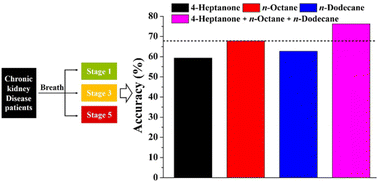Breath volatile organic compounds for chronic kidney disease progression monitoring†
Abstract
Breath analysis may provide a convenient and non-invasive method for clinical monitoring of chronic kidney disease (CKD) progression. However, few breath volatile organic compounds (VOCs) indicating progression of CKD have been reported. In this study, we used gas chromatography-mass spectrometry (GC-MS) for untargeted detection of breath VOCs in stage 1, 3, and 5 CKD patients. The results showed that, the levels of breath 4-heptanone, n-octane, and n-dodecane gradually increased from CKD stage 1 to stage 5, and their increasing rates from CKD stage 3 to stage 5 were higher than those from CKD stage 1 to stage 3. Gender, smoking habits, age, and body mass index (BMI) had insignificant impact on the levels of the three breath VOCs. The accuracies of the polynomial support vector machine (SVM) and K-nearest neighbour (KNN) models based on 4-heptanone + n-octane + n-dodecane combination in distinguishing CKD stages 1, 3, and 5 were 76.3% and 72.8%, respectively. The combination of 4-heptanone + n-octane + n-dodecane was superior to any single component for monitoring CKD progression. These discoveries have valuable implications for long-term clinical monitoring of CKD and improving our understanding of CKD.



 Please wait while we load your content...
Please wait while we load your content...